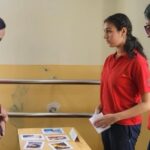Middle Years Programme (MYP) design curriculum manager Shadrach Pilip-Florea explores how computational thinking is present in everyday activities, why it’s an important skill for students to have in a 21st-century world and points to some resources to help facilitate its development in the classroom.

By Shadrach Pilip-Florea
What does a cook writing a new recipe, a tailor weaving on a loom and a sports fan analyzing football statistics to build a fantasy football team have in common? They are all using computational thinking.
When most of us hear the term ‘‘computational thinking’’, we naturally think of computers and other digital technologies. We are less likely to think about normal everyday activities like putting together a to-do list or planning the fastest path through a grocery store. Computational thinking draws upon the methods of computer scientists but at its core, it’s the thought processes that we go through when breaking down problems into distinct parts, looking for similarities, identifying important information and then creating a logical plan for a solution. It consists of concepts and techniques such as abstraction, decomposition, pattern recognition, algorithmic design and iteration from computer and information sciences but has broad application in the arts, sciences, humanities and everyday life.
These thinking skills are not new products of the information age but rather have been with us since the dawn of human ingenuity. Technologist Virginia Postel, in her recent book on the history of textiles, demonstrates how we can see computational thinking techniques embedded in the patterned fabrics we find in every human culture. Historian James Burke goes further speculating that the “precise sequential process that shaped the first axes later gave rise to the precise sequential thought that would eventually generate language”. Such speculation is impossible to prove but thinking computationally is something that all humans naturally do.
Today, humans are no longer the only computational agents. From smartphones to Zoom meetings, computers and digital technologies are embedded into all facets of our modern world. The algorithmic processes that underly those technologies increasingly shape our lives. Understanding these digital technologies and the processes behind them is a critical component of 21st-century education. To fulfill the IB mission, we want to go even further and prepare students so that they can design and use those technologies to create a more positive world. The IB learner profile encourages students to be thinkers who critically and creatively recognize and approach complex problems. Computational thinking informs critical and creative thinking as a way of reasoning to solve problems and design solutions.
Breakdown of computational thinking

Decomposition – breaking down a complex problem or system into smaller, more manageable parts.

Pattern recognition – looking for similarities among sets of data*.

Abstraction – focusing on the important information to formulate representational models or simulations. Organize and analyze data based on those abstractions*.

Algorithms – developing a step-by-step solution to the problem or the rules to follow to solve the problem*.

Debugging and iteration – testing algorithms to fix problems and make changes that achieve greater effectiveness and efficiency*.
Computational thinking across the IB programmes
PYP –> DP/CP
- Finding patterns
- Breaking problems into smaller parts
- The use of puzzles and problems
- Math and number play
- Computer games
- Use of concept maps and flow charts
- Robotics and simple programming
- Introducing algorithms
MYP –> DP/CP
- Integrating programmable environments and hardware technologies
- Integrating computational and numerical problem solving
- Focusing on algorithms
- Using data management methods in projects and problem solving
- Practicing iteration and debugging
- Connecting to design
- Emphasizing collaboration and multidisciplinary technical projects
Through explicitly teaching cognitive processes like computational thinking, IB teachers make thinking processes visible to students. Those who are more aware of their own thinking are likely to be active learners who have agency over their learning, and they also learn more deeply.
Thinking “computationally” is an intrinsically interdisciplinary skill; one that is transferable across a diverse range of problems in a wide variety of contexts. In the classroom, there are numerous ways to integrate computational thinking activities: from simple Primary Years Programme (PYP) activities such as identifying patterns or playing with numbers puzzles to more complex Middle Years Programme (MYP)/Diploma Programme (DP)/Career-related Programme (CP) activities such as building digital mathematical models, developing statistical indices, programming robotics or video games etc. There are numerous activities that develop computational thinking skills and they can also be applied in the arts and humanities through literary analysis, artistic projects and social science investigations.
The fundamental thinking processes behind computational thinking are the same across the different grade levels—it’s the complexity of the problems and types of computing systems that will grow over time. For example, the MYP design course prepares students for more complex problems by explicitly teaching them how to apply practical and creative thinking skills to solve authentic problems. It also gives students the space to develop the technical domain knowledge needed for some complex systems. These transferrable skills are also developed throughout the IB curriculum. The IB inquiry-based learning model teaches students to formulate questions, collect, analyse and interpret data. Through inquiry, students explore problems where they can practice thinking skills. Computational thinking is an important 21st-century method that students can employ to design and test solutions.
Potential classroom resources
Here are some resources that you can use to facilitate discussions about computational thinking:
- CS Unplugged – A collection of free learning activities that teach computer science through engaging games and puzzles that use cards, string, crayons and lots of running around.
- Google for Education: Exploring Computational Thinking – The resources, including the curated collection of lesson plans, videos, and other resources were created to provide a better understanding of computational thinking (CT) for educators and administrators and to support those who want to integrate CT into their own classroom content, teaching practice and learning.
- International Challenge on Informatics and Computational Thinking – The Bebras challenges are made of a set of short problems called Bebras tasks and are delivered online. The tasks are fun, engaging and based on problems that computer
- Project GUTS – Growing Up Thinking Scientifically (GUTS) is an integrated science and computer science programme for middle school students serving schools and districts internationally. Teacher resources include a variety of classroom-ready lessons.
- ScratchEd – An archive of discussions, resources and stories around the use of Scratch block-based programming language in education.
- SageModeler – Free, web-based and open-source software to engage students in systems thinking through designing, building and revising models. Classroom-ready lessons and activities.
- MIT App Inventor – MIT App Inventor is an intuitive, visual programming environment that allows everyone—even children—to build fully functional apps for smartphones and tablets.
References
[1] James Burke and Robert Ornstein (1997). The Axemaker’s Gift: Technologies capture and control of our minds and culture. TarcherPerigee.
[2] Peter Denning and Mattie Tedre (2019) Computational Thinking. MIT Press Essential Knowledge Series.
[3] Virginia Postrel (2020) The Fabric of Civilization: How Textiles Made the World. Basic Books.
[4] Jeannette M. Wing. (2010) Computational Thinking: What and Why? 17 November 2010.
[5] James D Slotta, Jie Chao, Mike Tissenbaum (2020). Fostering computational thinking and design thinking in the PYP, MYP and DP.
* Images provided courtesy of Ecosia

Shadrach Pilip-Florea is the Middle Years Programme (MYP) design curriculum manager. He is a former designer and professional project manager with a master’s degree in Urban and Regional Planning (University of California at Los Angeles) before becoming an IB teacher and curriculum designer. Originally from Portland, Oregon USA, Shadrach has lived and worked in Spain, China, and the west coast of the United States. He now lives in The Hague, Netherlands with his partner and two hilarious daughters that are also Primary Years Programme (PYP) students.
Have a look to see how Fairgreen International School is integrating computational thinking in their Middle Years Programme (MYP) science curriculum. Are you using computational thinking in your schools, programmes or classrooms? Send us your story to share with the wider IB community. For more information about computational thinking in the IB programmes, check out this independent research study. There is a section that provides guidance for future curriculum and implementation practices in the IB as well as recommendations for schools.
If you enjoyed this story, consider reading more below:



